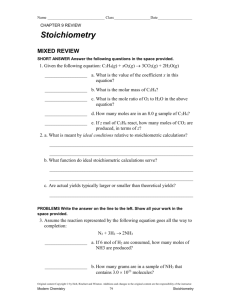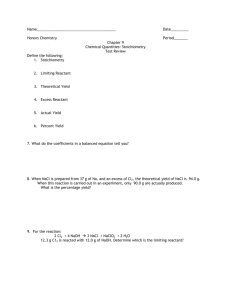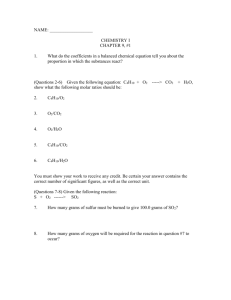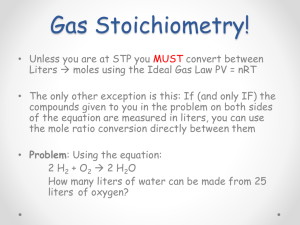Chap. 4 - Stoichiometry
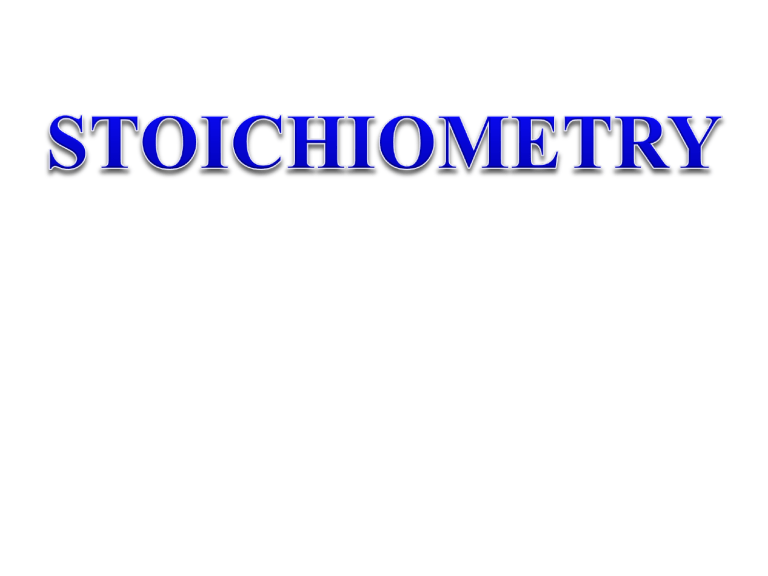
Reaction Stoichiometry
• the numerical relationships between chemical amounts in a reaction is called stoichiometry
• the coefficients in a balanced chemical equation specify the relative amounts in moles of each of the substances involved in the reaction
2 C
8
H
18
( l ) + 25 O
2
( g )
16 CO
2
( g ) + 18 H
2
O( g )
2 molecules of C
8
H
18 react with 25 molecules of O
2 to form 16 molecules of CO
2 and 18 molecules of H
2
O
2 moles of C
8
H
18 react with 25 moles of O
2 to form 16 moles of CO
2 and 18 moles of H
2
O
2 mol C
8
H
18
: 25 mol O
2
: 16 mol CO
2
: 18 mol H
2
O
Predicting Amounts from
reaction can be determined from the amount of just one substance
• How much CO
2 can be made from 22.0 moles of
C
8
H
18 in the combustion of C
8
H
18
?
2 C
8
H
18
( l ) + 25 O
2
( g )
16 CO
2
( g ) + 18 H
2
O( g )
2 moles C
8
H
18
: 16 moles CO
2
22.0
moles C
8
H
18
16 mol CO
2
2 mol C
8
H
18
176 moles CO
2
Stoichiometry
1. Finely divided sulfur ignites spontaneously in fluorine to produce sulfur hexafluoride according to the following unbalanced equation:
S(s) + F
2
(g)
SF
6
(g)
A. How many grams of SF
6
(g) can be produced from 5.00 g of sulfur?
B. How many grams of fluorine are required to react with the 5.00 g of sulfur?
2. Deuterated ammonia, ND
3
(g), can be prepared by reacting lithium nitride with heavy water, D
2
O(l), according to the following equation:
Li
3
N(s) + D
2
O(l)
LiOD(s) + ND
3
(g)
A. How many milligrams of heavy water are required to produce
7.15 mg of ND
3
(g)? Take the atomic mass of deuterium to be 2.014 amu.
B. Given that the density of heavy water is 1.106 g/mL at room temperature, how many milliliters of heavy water are required?
Workshop on Balancing Chemical Equations & Stoichiometry
1. Balance the following chemical equations shown below:
A. KClO
3
(s)
KCl(s) + O
2
(g)
B. NH
3
(g) + O
2
(g)
N
2
(g) + H
2
O(g)
C. Fe(s) + H
2
O(g)
Fe
3
O
4
(s) + H
2
(g)
D. H
2
S(g) + SO
2
(g)
H
2
O(l) + S(s)
2. A frequently used method for preparing oxygen in the laboratory is by the thermal decomposition of potassium chlorate according to the following unbalanced chemical equation:
KClO
3
(s)
KCl(s) + O
2
(g)
How many grams of O
2
(g) can be prepared from 30.6 g of
KClO
3
(s)?
3. Consider the combustion of propane, C
3
H
8
.
A. How many grams of O propane?
2 are required to burn 75.0 g of
B. How many grams of CO
2 are produced?
Limiting Reagent
When chemicals are mixed together to undergo a reaction, they are often mixed in stoichiometric quantities, that is, in exactly the correct amounts so that all reactants “run out” at the same time.
However, if one or more reactant(s) is used in excess, then the scarce reagent is called the limiting reagent (or reactant). In any stoichiometric problem, it is ESSENTIAL to determine which reactant is limiting in order to calculate correctly the amounts of products that will be formed.
A mixture is prepared from 25.0 g of aluminum and 85.0 g of Fe
2
O
3
. The reaction that occurs is described by the following equation:
Fe
2
O
3
(s) + Al(s)
Al
2
O
3
(s) + Fe(l)
How much iron is produced in the reaction?
Workshop on Limiting Reagent
1. Calcium sulfide can be made by heating calcium sulfate with charcoal at high temperature according to the following unbalanced chemical equation:
CaSO
4
(s) + C(s)
CaS(s) + CO(g)
How many grams of CaS(s) can be prepared from 100.0 g each of
CaSO
4
(s) and C(s)? How many grams of unreacted reactant remain at the end of this reaction?
2. If 21.4 g of solid zinc are treated with 3.13 L 0.200 M HCl, how many grams of hydrogen gas will theoretically be formed? How much of which reactant will be left unreacted? The products of this reaction are hydrogen gas and zinc chloride.
Percentage Yield
Percent yield =
Actual Yield
Theoretical Yield x 100
1. Liquid tin(IV) chloride can be made by heating tin in an atmosphere of dry chlorine. If the percentage yield of this process is 64.3%, then how many grams of tin are required to produce 0.106 g of the product?
2. Aluminum burns in bromine, producing aluminum bromide. When 6.0 g of aluminum was reacted with an excess of bromine, 50.3 g of aluminum bromide was isolated. Calculate the theoretical and percent yield of this reaction.
Workshop on Percentage Yield
1. A 0.473-g sample of phosphorus is reacted with an excess of chlorine, and 2.12 g of phosphorus pentachloride is collected. What is the percentage yield of the product?
2. A century ago, sodium bicarbonate was prepared from sodium sulfate by a three-step process:
Na
Na
2
S(s) + CaCO
3
Na
2
2
SO
CO
4
3
(s) + 4C(s)
(s) + H
2
(s)
Na
2
S(s) + 4CO(g)
CaS(s) + Na
2
CO
3
(s)
O(l) + CO
2
(g)
2NaHCO
3
(s)
How many kilograms of sodium bicarbonate could be formed from one kilogram of sodium sulfate, assuming an 82% yield in each step?
STOICHIOMETRY & PERCENT
1. Impure nickel can be purified by first forming the compound Ni(CO)
4
, which is then decomposed by heating to yield very pure nickel. Metallic nickel reacts with gaseous carbon monoxide as follows:
Ni (s) + 4 CO (g) → Ni(CO)
4
(g)
Other metals present do not react. If 94.2 g of a metal mixture produces 98.4 g of Ni(CO)
4
, what is the mass percent of nickel in the original sample?
2. A 1.0000g sample of XI
2 is dissolved in water, and excess silver nitrate is added to precipitate all if the iodide as silver iodide. The mass of the dry AgI, is found to be 1.375g. Calculate the molar mass of X.
